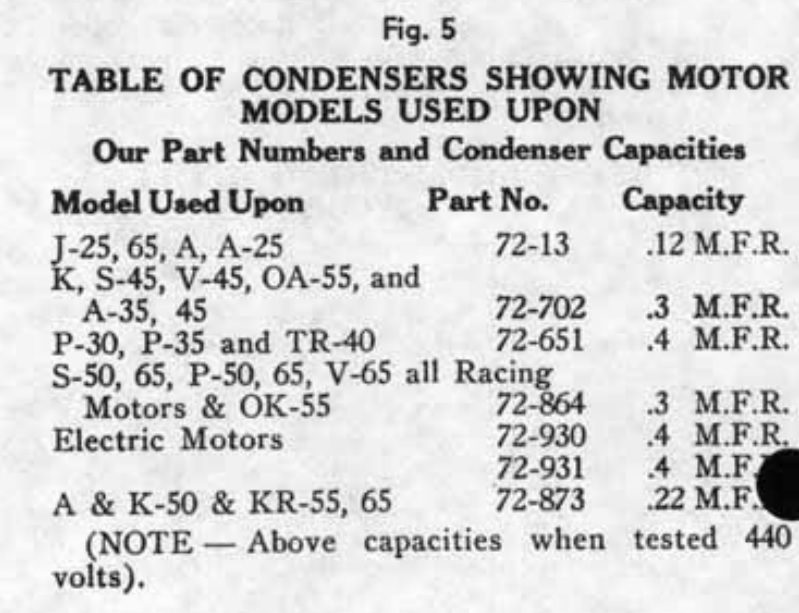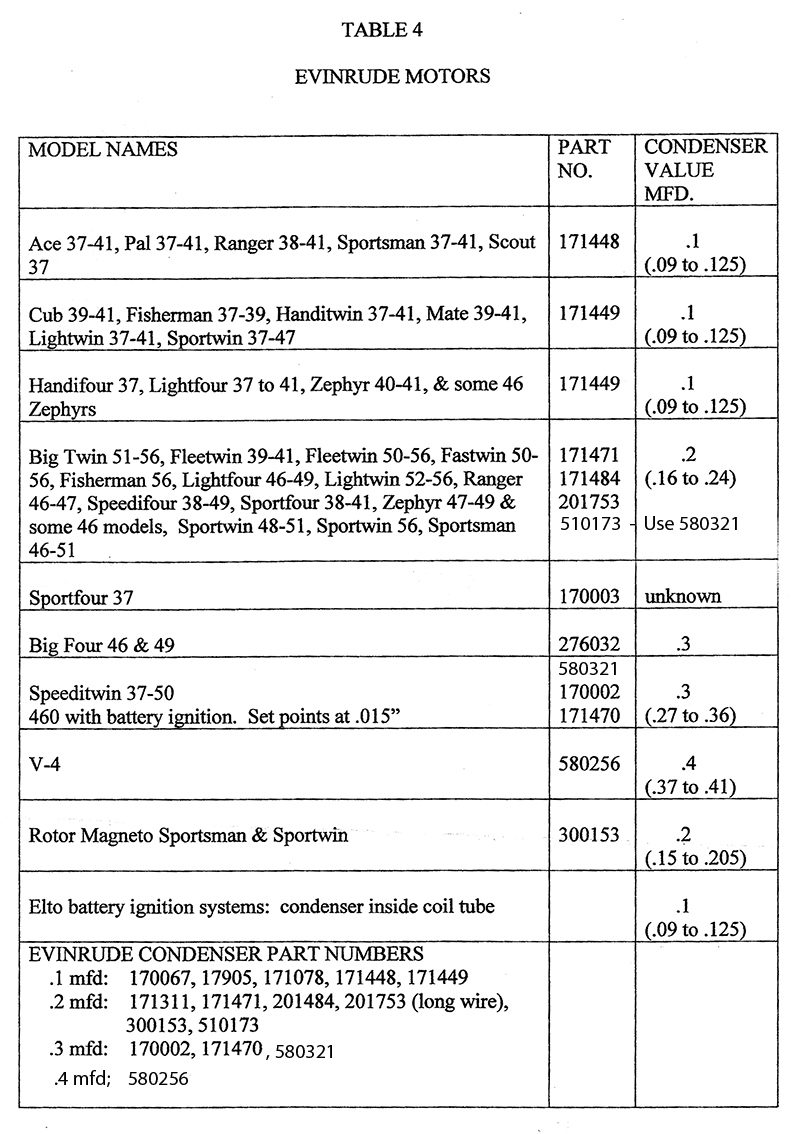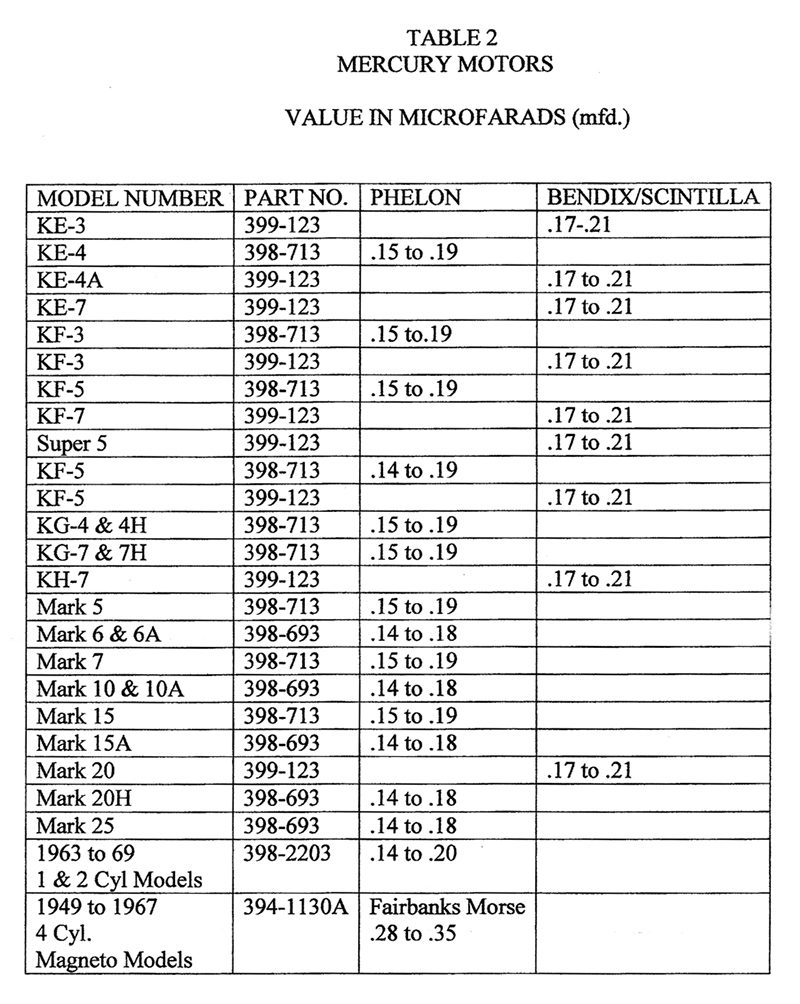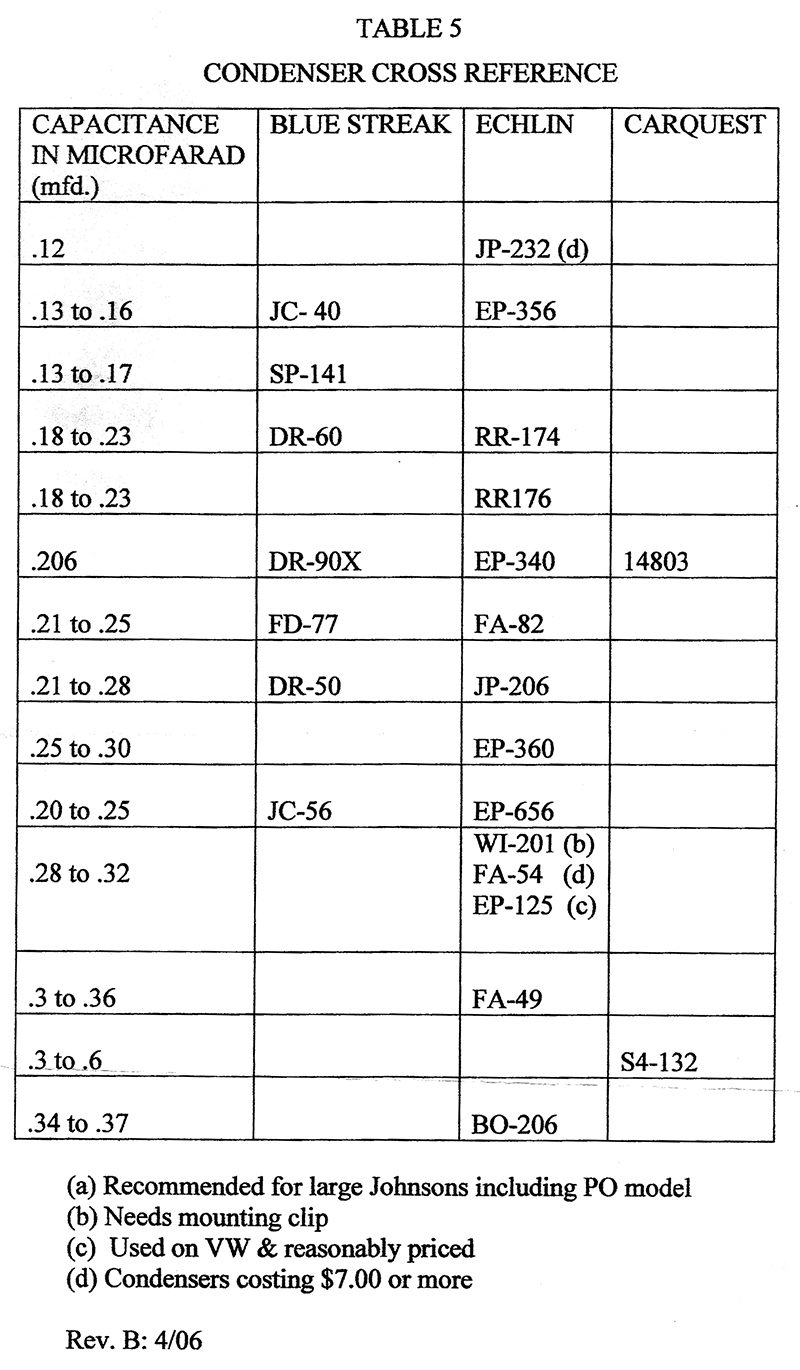Home › Forum › Ask A Member › Coil + Condenser Pairing ???
- This topic has 14 replies, 8 voices, and was last updated 2 years ago by
Matthew Pieklik.
-
AuthorPosts
-
October 22, 2023 at 9:58 am #281934
Team,
Just bought a Merc O Tronic 98 in an attempt to get better with electrical diagnosis. This thing should show me coil health and, condenser health. In my restorations however, I usually have to convert to new coils and, new condensers. Question is, how do I appropriately size a condenser to a coil? Is there a math equation I should learn? Is it a trial and error thing? Is there a tried and true condenser I could use for everything less than 5hp? I think one of the issues I’m having is a spark shortcoming as a result of mismatched components. Any help here is appreciated. Currently this is all a mystery.
October 22, 2023 at 10:09 am #281936Team,
Just bought a Merc O Tronic 98 in an attempt to get better with electrical diagnosis. This thing should show me coil health and, condenser health. In my restorations however, I usually have to convert to new coils and, new condensers. Question is, how do I appropriately size a condenser to a coil? Is there a math equation I should learn? Is it a trial and error thing? Is there a tried and true condenser I could use for everything less than 5hp? I think one of the issues I’m having is a spark shortcoming as a result of mismatched components. Any help here is appreciated. Currently this is all a mystery.
I have pondered, but never have heard an answer to your question of
coil to condenser “match”. Best to just keep it as “simple” as possible.
If you’re using OMC Universal coils in your swaps, jut use the condensers
with the correct MFD’s intended for those coils.
There are charts someone put together with many examples showing
“what” outboards used “what” condenser mfd ratings.
Do you have those?Prepare to be boarded!
1 user thanked author for this post.
October 22, 2023 at 10:35 am #281938Those charts would be awesome. I do not have them. That might be the piece I’m missing. I’m also noticing that aftermarket condensers list their part numbers but, they rarely list their uF values..
October 22, 2023 at 12:59 pm #281943October 22, 2023 at 1:00 pm #281948October 22, 2023 at 1:24 pm #281951Hmmm. One of the issues is that resistance and other values change when particular parts are updated/superceded. In other words, the primary/secondary resistance/power settings have changed from the original coils/condensers used on the “universal mag” versus the latest OEM replacements. So, it can be tough to know the correct test procedures/values even though you have the part number. The only way to really know is to scour service manuals until you find the test procedures related to the part number you have.. One other method might be to have a “known good” piece with the same part number so readings can be compared.
Right now (at least to the best of my knowledge), all universal mag coils have been superceded to the same part number. There are two different condensers used based on the horsepower of your engine. So, I’m thinking the condenser is not just “matched to the coil”, but also matched to the particular engine’s spark requirements.
All of this doesn’t even touch on aftermarket replacement pieces, you would have to contact the manufacturer to get those specs. Perhaps mercotronic has a listing for aftermarket pieces. Again, the best tool in this situation is a “known good” piece of the same part number.
October 22, 2023 at 2:23 pm #281952One other bit of information I believe I read in an “Outboarder” article is that you can safely use condensers of significantly higher mfd. than specified.Problems start to occur when condenser values are lower than spec.
1 user thanked author for this post.
October 22, 2023 at 4:02 pm #281961MR.Mohat pubished several articles on condensers and all the info is on the western region aomci site. as it turns out .22uf is pretty much the universal value
see articles and decide to big saves the points and drops the spark to small gets you a big spark and burns the points …..
Microsoft Word – Part1_Condenser_Construction_Failure_Modes.doc (wrcoutboards.org)
https://wrcoutboards.org/wp-content/uploads/2020/04/Part3_Sizing_Condensers_Correctly.pdf
https://wrcoutboards.org/wp-content/uploads/2020/04/Part4_Repairing_Broken_Condensers.pdf
mr. Mohat conclusion in article 3
I believe we can make the following generalizations and recommendations:
Motors, 1900s – (MASSIVE steel magnets, 2 pole / 2 pole construction, absolutely HUGE spark
coils)….use a .68 to 1.0uF condenser. Error on going too large, to protect the insulation in your
antique spark coil if possible…as long as your motor can be started easily.Motors 1910s through 1920s (STEEL MAGNETS, 2 pole / 2 pole construction, very large spark
coil)….use a .47uF to .68uF condenser. Again, error on going larger than this, as long as you
can start the motor easily!Motors 1930s and 1940s (Steel Magnets, typically 2 pole / 3 pole construction, “medium” size
spark coils)….use a .3 to .47uF condenser.Motors 1930s and 1940s, (Alnico Magnets, 2 pole / 3 pole construction, smaller size spark
coils)….use a .22 to .47uF condenser.Motors 1950s and newer (all)….just use a .22uF. It REALLY isn’t at all critical, apparently!
Also note that almost all 12V “Battery and Points” ignition systems seem to use something close
to 0.22uF as well, so this is sort of your ‘universal replacement’ value.Joining AOMCI has priviledges 🙂
2 users thanked author for this post.
October 22, 2023 at 5:11 pm #281962Ben at the risk of oversimplification, may I suggest looking at the subject in a layman’s manner? Think of electricity as “stuff”. Actually electrons, those little pieces of stuff that whiz around an atom as planets whiz around the sun. Think of a condenser as a closed can with a wire leading into the can. Magnets passing by a coil of wire drag those electrons out of their atoms, shove them through a circuit and back to the other end of the coil when the point are closed. When the points suddenly open, the electrons want to keep moving for a short bit of time. They will try to jump the gap across the points, making an arc which burns the points. A condenser gives them a place to go instead, that place being the “can”. They are crammed into the “can” by whatever pressure is driving them. That pressure is what we call “Voltage”.
Now, comes the matter of “capacity”. The capacity of a condenser determines how many electrons can be crammed into it at a given voltage. It fills up with electrons till the voltage inside the can equals the pressure pushing them in. This takes time. Too big a can takes too long to fill, and the voltage doesn’t rise enough. Too small a can and it won’t hold all the available electrons. Add to all this, a leaking condenser spills some of the electrons out to ground. Why does all this matter anyway? Because at this critical point in time when the points open, the polarity of the coil changes and the stored electrons flow back out of the can, in series with the changed voltage in the coil. This adds to the spark obtained in the secondary winding of the coil.
Bottom line is, there is no magic number for the capacity of the condenser. A lot depends on the strength of the magnets dragging the electrons, the size and magnetic properties of the coil, the RPM or speed at which the magnets pass by the coil, etc, etc. In other words, the electrical engineers that designed the system arrived at a best value for the system under all or average conditions.
And that’s what it is, the “average”. Notice there isn’t much difference between the smallest and larges capacities listed.
1 user thanked author for this post.
October 22, 2023 at 7:09 pm #281975Thanks,
You’ve responded to a couple of my posts here. I appreciate the help. I replaced a coil in a Handitwin with a replacement from Ebay (Big Rich). When talking with you in the past you said you’ve paired this coil with a .22 uF condenser from Brillman. I just tested my combo and, my condenser tests at .1 uF. I think my condenser is undersized… Cylinder pressures in the 50s.. Runs but sometimes starts running rough. Plug is often wet in one cylinder when I pull it. I’m thinking the undersized condenser doesn’t always fire the second cylinder (wet plug)… If that’s the case, know of any new condenser that’s the go-to for .22 uF.? Thanks again.
Ben
-
AuthorPosts
- You must be logged in to reply to this topic.






